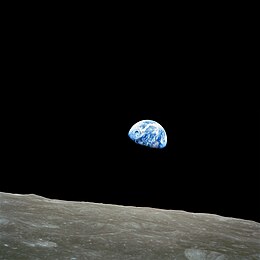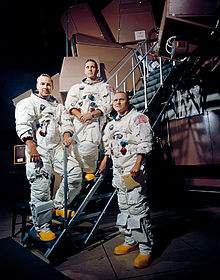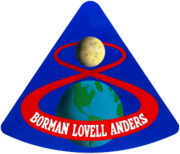Apollo 8

Apollo 8's crew were the first to witness an Earthrise, on December 24, 1968. This photograph, Earthrise, was taken by Lunar Module Pilot William Anders.
|
|
| Mission type | Manned Lunar orbiter |
|---|---|
| Operator | NASA |
| COSPAR ID | 1968-118A |
| SATCAT no. | 3626 |
| Mission duration | 6 days, 3 hours, 42 minutes |
| Spacecraft properties | |
| Spacecraft |
|
| Manufacturer | North American Rockwell |
| Launch mass |
|
| Landing mass | 4,979 kilograms (10,977 lb) |
| Crew | |
| Crew size | 3 |
| Members | |
| Callsign | Apollo 8 |
| Start of mission | |
| Launch date | December 21, 1968, 12:51:00 UTC |
| Rocket | Saturn V SA-503 |
| Launch site | Kennedy LC-39A |
| End of mission | |
| Recovered by | USS Yorktown |
| Landing date | December 27, 1968, 15:51:42 UTC |
| Landing site | North Pacific Ocean 8°8′N 165°1′W / 8.133°N 165.017°W |
| Orbital parameters | |
| Perigee | 184.40 kilometers (99.57 nmi) |
| Apogee | 185.18 kilometers (99.99 nmi) |
| Inclination | 32.15 degrees |
| Period | 88.19 minutes |
| Epoch | December 21, 1968, ~13:02 UTC |
| Revolution no. | 2 |
| Lunar orbiter | |
| Spacecraft component | CSM |
| Orbital insertion | December 24, 1968, 9:59:20 UTC |
| Departed orbit | December 25, 1968, 6:10:17 UTC |
| Orbits | 10 |
| Orbit parameters | |
| Periselene | 110.6 kilometers (59.7 nmi) |
| Aposelene | 112.4 kilometers (60.7 nmi) |
| Inclination | 12 degrees |
 Left to right: Lovell, Anders, Borman |
|
Apollo 8, the second manned mission in the United States Apollo space program, was launched on December 21, 1968, and became the first manned spacecraft to leave Earth orbit, reach the Earth's Moon, orbit it and return safely to Earth. The three-astronaut crew—Commander Frank Borman, Command Module Pilot James Lovell, and Lunar Module Pilot William Anders—became the first men to travel beyond low Earth orbit, the first to see Earth as a whole planet, the first to directly see the far side of the Moon, and then the first to witness Earthrise. The 1968 mission, the third flight of the Saturn V rocket and that rocket's first manned launch, was also the first manned launch from the Kennedy Space Center, Florida, located adjacent to Cape Canaveral Air Force Station.
The mission was originally planned as Apollo 9, to be performed in early 1969 as the second test of the complete Apollo spacecraft, including the Lunar Module and the Command/Service Module in an elliptical medium Earth orbit. But when the Lunar Module proved unready to make its first test in a lower Earth orbit in December 1968, it was decided in August to fly Apollo 8 in December as a more ambitious lunar orbital flight without the Lunar Module. This meant Borman's crew was scheduled to fly two to three months sooner than originally planned, leaving them a shorter time for training and preparation, thus placing more demands than usual on their time and discipline.
...
Wikipedia

